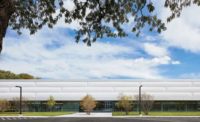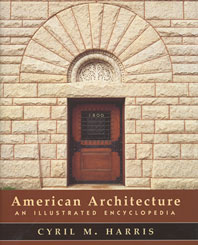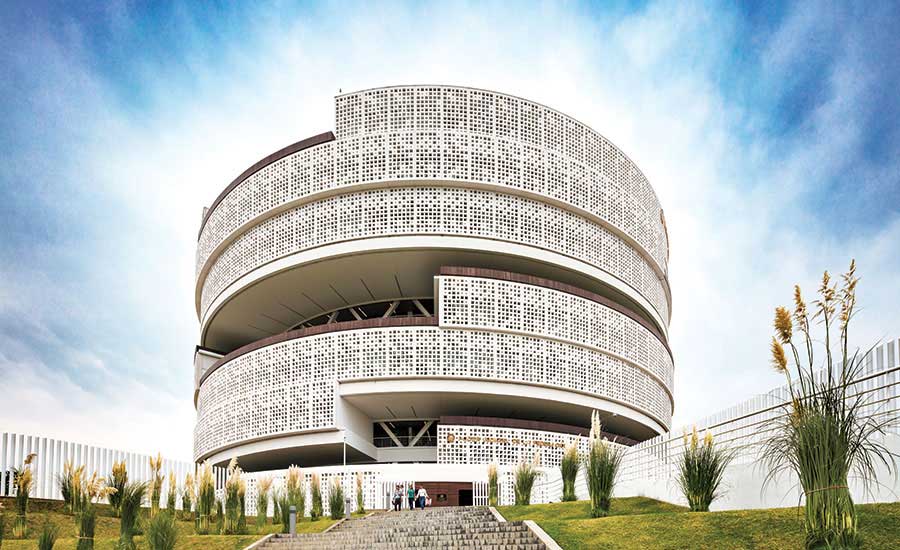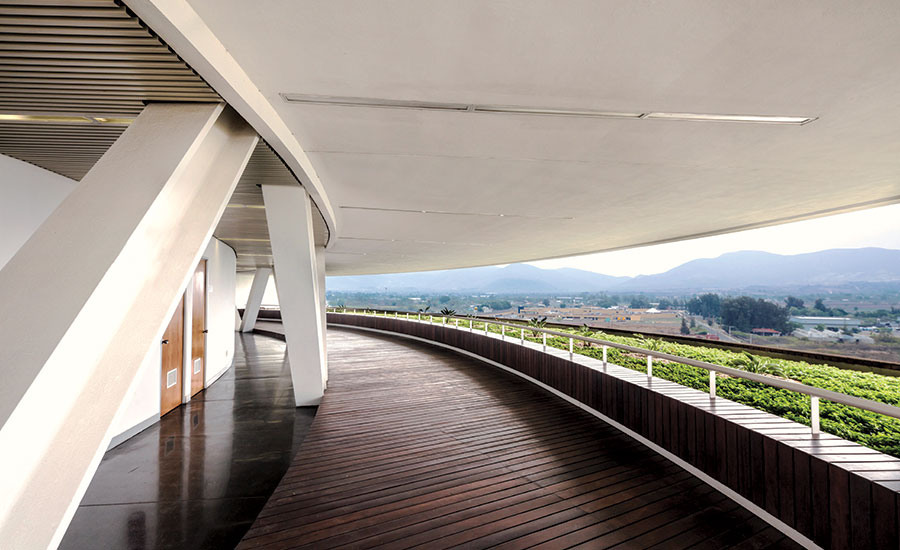Federal Courthouse by TEN Arquitectos
Oaxaca, Mexico

Photo © Luis Gordoa

The central courtyard is open to the sky.
Photo © Luis Gordoa

Each level is encircled with planters featuring a local flower, green here but since grown to a bright yellow bloom. The ground floor mixes planks of a local teak with planted areas.
Photo © Luis Gordoa

The same black terrazzo of the circular corridors’ floors is used in the built-in seating.
Photo © Luis Gordoa

A dining hall extends from the circular plan at grade, where there are light wells for the underground parking.
Photo © Luis Gordoa

Partial terraces on each floor offer panoramic views over the fields and to the mountains in the distance.
Photo © Luis Gordoa

Image courtesy TEN Arquitectos

Image courtesy TEN Arquitectos

Image courtesy TEN Arquitectos

Image courtesy TEN Arquitectos










Architects & Firms
With the exception of a few imposing stone church towers, often at one end of a large square, almost everything in Oaxaca stays pretty close to the ground. The colorful one- and two-story buildings that line the streets of this central Mexican city conceal charming and varied courtyards, many rich in plantings or architectural details. Leave the dense, rigid grid of the center and the same low scale holds true.
Additional Content:
Jump to credits & specifications
A regional municipal complex about a half hour’s drive from the city, near the town of San Bartolo Coyotepec, comprises several typically squat and, frankly, unremarkable structures—for a specialized hospital, an AIDS clinic, and a criminal court, among other government offices. The exception here however, is the collection’s latest addition. At 10 stories, the new courthouse is the tallest structure for miles. Its height, combined with its startling round shape and striking perforated facade, has turned this bureaucratic building into a beacon in the mainly agricultural landscape.
“This is clearly a building as object,” says its architect, Enrique Norten, of Mexico City– and New York–based TEN Arquitectos, which won an invited competition for the project. “It is so isolated from everything; there’s no sense of urbanity.”
While many of the 750 workers within the new building lament the move from dispersed locations within the center of Oaxaca, the new centralized facility allows cases—which deal primarily in constitutional and civil law—to move along more efficiently by allowing faster communication between judges. In total, nine of the 11 federal judges within the state of Oaxaca serve here. A small percentage of criminal cases are handled in this building, but the main criminal courthouse is next door, separated by a landscaped yard and 10-foot-high wall. Nevertheless, entrance inside is strictly limited, so most people will only get to experience the new courthouse as an object in the landscape.
The building’s circular form grew around the desire for a central courtyard, or patio, so essential in traditional Mexican architecture. But here it is made completely contemporary. That soaring space, like most patios, is lined with greenery and open to the sky. Within that roofless atrium are the most accessible parts of the building. The planted, teak-clad ground floor at the center, with café seating for visiting attorneys and the curving terrazzo-clad corridors above it, serving mainly as circulation and waiting areas, are exposed to the elements, though within this climate that often means a soft gust of wind rather than much chance of rain.
Spaces become increasingly private as one moves away from the center toward the perimeter of the donut-shaped plan, where glazed offices and judge’s chambers are located. Positioned behind the perforated facade, these rooms feature either operable windows that allow breezes, or fixed glazing with air-conditioning. “We gave the option to the users,” says project architect Melissa Fukumoto. “Many judges preferred to be closed in. I suppose it has to do with how they work.”
For moments when they want a break from that work, each floor is equipped with a large terrace, planted and lined in the same durable teak as the floor of the interior courtyard. Says Norten, “The terraces are for conversations, for looking at the mountains on one side and the valley on the other.” The position of these “outdoor rooms,” as Norten calls them, changes in plan at each level, so that the spiraling openings along the facade add dynamism to the otherwise platonic cylindrical form.
The perforated concrete panels of the facade were precast at a Mexican facility and installed as modules, with the 14-foot height of each panel corresponding to a full story. Eight different geometric patterns were developed—the ones that are more open were used to clad offices and, those that are less open, more secure areas.
The overall effect is bold, playful even, considering what goes on inside. But, more than anything, the use of the precast panels was incredibly clever. Norten’s office developed the design of the building knowing it would not be able to oversee construction. Each element, including the structure—concrete combined with a steel ring truss around the building’s core—was kept as simple as possible.
Norten’s office had certain advantages and disadvantages building the new courthouse. Because it’s a federal building, TEN Arquitectos had a bigger budget for its design but less control over the finished product. In the end, though, it worked out well. This is a building entirely of its place yet one that, literally and figuratively, rises above much of what’s been built there in recent years.
CreditsArchitect: TEN Arquitectos Cuernavaca 114 PB; Col. Condesa C.P. 6140, Ciudad de México +5255 52118004
Personnel in architect's firm who should receive special credit: Partner in charge: Enrique Norten, FAIA Project architect: Melissa Fukumoto Project team: Ernesto Vázquez, Eduardo Ezeta, Daniel Hernández, Aarón Pérez, Carlos Salas, Emelio Barjau, Elvia Navarrete, Roberto Cerezo, Edgar Durán, Salvador Arroyo
Associate architect(s): Daniel López Salgado
Engineers: Structural Engineering: CTC Ingenieros Civiles MEP: High Tech Services Soil Mechanics: TGC Geotécnia
Consultants: Lighting: Ideas en Luz
General contractor: Secretaría de la Defensa Nacional
Photographer: Luis Gordoa (Cell: +5255 15341641 / office: +5277 73127347) |
SpecificationsGlazing: Vitro Precast concrete: Fapresa Acoustical ceilings: Hunter Douglas, Armstrong Paint: Comex Floor tile: Interceramic Bathroom fittings: Helvex Industrial kitchen: Grupo Delia |
















